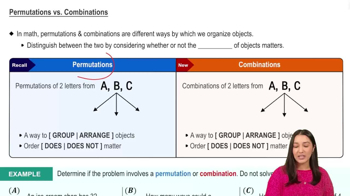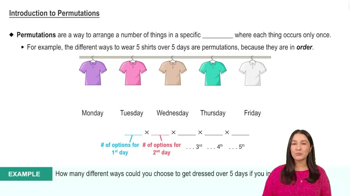Here are the essential concepts you must grasp in order to answer the question correctly.
Permutations and Combinations
Permutations and combinations are fundamental concepts in combinatorics that deal with counting arrangements and selections of items. Permutations refer to the different ways to arrange a set of items where order matters, while combinations refer to selections where order does not matter. In this question, we need to consider the arrangements of beads, which involves permutations of multiset due to the presence of identical items.
Recommended video:
Permutations vs. Combinations
Multiset Permutations
A multiset is a generalized concept of a set that allows for multiple occurrences of the same element. The formula for calculating the number of distinct permutations of a multiset is given by n! / (n1! * n2! * ... * nk!), where n is the total number of items, and n1, n2, ..., nk are the counts of each distinct item. This is crucial for solving the necklace problem, as it accounts for the indistinguishable beads of the same color.
Recommended video:
Introduction to Permutations
Circular Permutations
Circular permutations refer to arrangements of items in a circle, where rotations of the same arrangement are considered identical. The formula for circular permutations of n distinct items is (n-1)!. However, when dealing with indistinguishable items, adjustments must be made to account for the repetitions. In this necklace problem, we must apply the circular permutation concept to find the number of unique arrangements of the beads.
Recommended video:
Introduction to Permutations
 Verified step by step guidance
Verified step by step guidance Verified video answer for a similar problem:
Verified video answer for a similar problem:



 7:11m
7:11m